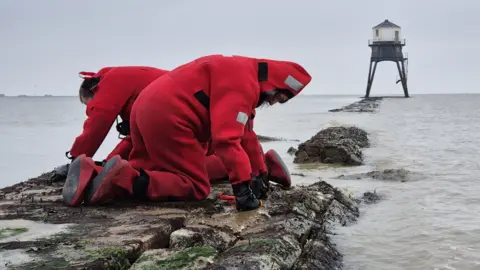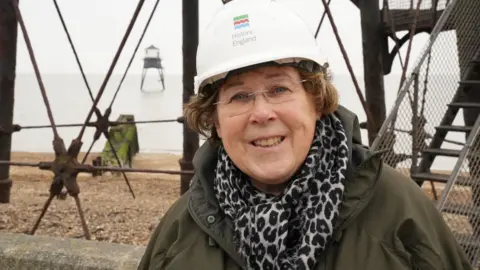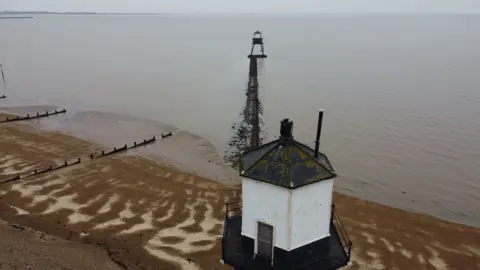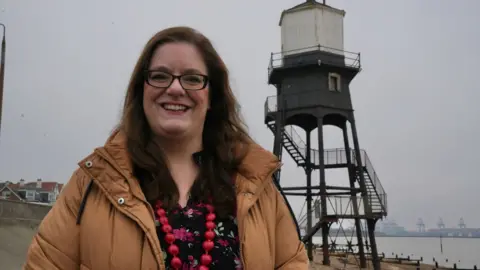Iconic lighthouses could cost millions to repair
 Stuart Woodward/BBC
Stuart Woodward/BBCThe cost of repairing two Victorian lighthouses on the Essex coast could run into millions of pounds, according to conservationists.
The structures at Dovercourt, near Harwich, are thought to be the only pair of their kind remaining in England, but corrosion has caused holes in the iron framework.
A survey - organised by Tendring District Council and funded by Historic England and the National Heritage Lottery Fund - is under way to assess the extent of the damage.
"We are very concerned," said Trudi Hughes from Historic England.
'Angel of the North'
The lighthouses were built in the 1860s and were decommissioned in 1917.
Historic England listed the structures and added them to its at Risk Register in 2019.
The council says the two iconic towers are the only pair of leading lighthouses - that are made of iron - that are still standing in England.
"I think of them as a bit like the Angel of the North," said Trudi Hughes.
"They give you a sense of place - you know you've arrived in Dovercourt."
Ms Hughes described the lighthouses as "super-well engineered" with "technologically-innovative" screw piles driven deep into the sand for stability.
 John Fairhall/BBC
John Fairhall/BBCEd Morton is a conservation-accredited engineer and managing director of The Morton Partnership, which is one of the teams involved in the project.
"It's amazing how far the Victorians went for a very utilitarian industrial structure to make them nice," said Mr Morton.
"There's a careful balance between how far you go, respecting the significance and importance of the structures that you're working on."
 John Fairhall/BBC
John Fairhall/BBCThe survey of the lighthouses - and the causeway which links the two - is costing more than £55,000, with the vast majority paid for by Historic England's Repair Grants for Heritage at Risk funding, as well as leftover money from a previous structural survey which was paid for by the National Heritage Lottery Fund.
The results of the survey are expected within the next few months, which will then determine how much work is required to repair the lighthouses.
"It's the structure in the 'splash zone' which has been particularly affected," said Mr Morton.
He said the beach would have been "three or more metres" lower in Victorian times, compared with today.
"My gut feeling at the moment is that [the repair costs] are likely to be into the low millions," Ms Hughes said.
 John Fairhall/BBC
John Fairhall/BBCJessica Bryan, the arts and events manager at the council, said the team was "really realistic" that anything to do with heritage assets was "very expensive".
"We have to get it right, what we do now - we have to keep that momentum going," she said.
"We want to make sure these [lighthouses] are within the area for many years to come and enjoyed for many generations."
Mr Morton added that the project was "absolutely" worth the big cost.
"It's rare to me that I've seen so many local people stop and tell us of their love of [the lighthouses]," he explained.
"I think it's really important that we do conserve and save the structures."
Follow Essex news on BBC Sounds, Facebook, Instagram and X.
